The Top 5 Ways to Improve Quality Systems with Lean Manufacturing
How do we use Lean Manufacturing methods improve quality systems? Over the years, while introducing Lean programs into manufacturing companies, the Lean programs overall results has a lot to do with how well the company’s quality process/system is performing. Often having to adjust/improve the quality processes as the Lean programs becomes established.
In order to achieve this there are a few key steps that will help integrate your quality system when combining it with Lean methodologies. Start with raising awareness for reducing ‘Waste’ across all of the manufacturing processes. These can be discovered by:
Developing Shop Floor Relevant Quality Metrics
The key quality metics need to be identified at each stage and determined how each metric is generated. These could be Defects per Unit, Sigma level or supplier score. Each metric needs to pass the SMARTER guidelines to be specific, measurable, attainable, relevant, and time-bound, along with processes to evaluate and reevaluate metrics. By defining metrics first, there is a clear focus on potential problems (Muda) and then you will be able to drill-down to more details and then to develop action plans to improve the metric.
Display Quality Metrics
Often all things quality are filed away in a team leaders folder or with the Quality group, where the information is stored in a static condition. Incorporating visual quality metrics into a manufacturing process is an important step towards improving quality consistency across your manufacturing processes. These metrics become an effective way to deliver accurate and easily understandable information for everyone across the organisation.
Perform Quality Inspections As Close to the Shop Floor As Possible
This means embedding your quality processes within production. This approach demands visibility and control over your quality processes to occur in real time. Inspections are performed as part of the process and results displayed. Problem Solving can then start at the detection stage.
Inspect Early in the Process and at the End of Each Process Handover

One of the highest costs of quality is a defective part or material that forces you to discard an entire batch or part. It is known that the further along the process you are, the more costly and problematic it is to resolve the defect and its causes. Therefore you need to inspect with due diligence (during and after each step), using defined documented inspection plans which ensure a right first time behaviour is followed.
Implement and Enforce Baseline Best Practices
Start thinking seriously about how you can replicate improved quality procedures across your manufacturing processes. As a new best practices are identified and validated, there needs to be a process in place to implement them as the new “way we work here”. One idea is to create an internal “Centre of Excellence”, whether it is big (training centre) or small (Simple folder). Then the new baselines methods are documented and added as “standards” for the company.
Summary
By implementing these changes to your quality system you will be able to further enforce the outcome of a Lean manufacturing system. So consider, how does your company make use Quality metrics? How well are you faring in your Lean program? Please talk with us about the best way to integrate your efforts to improve overall company excellence.






